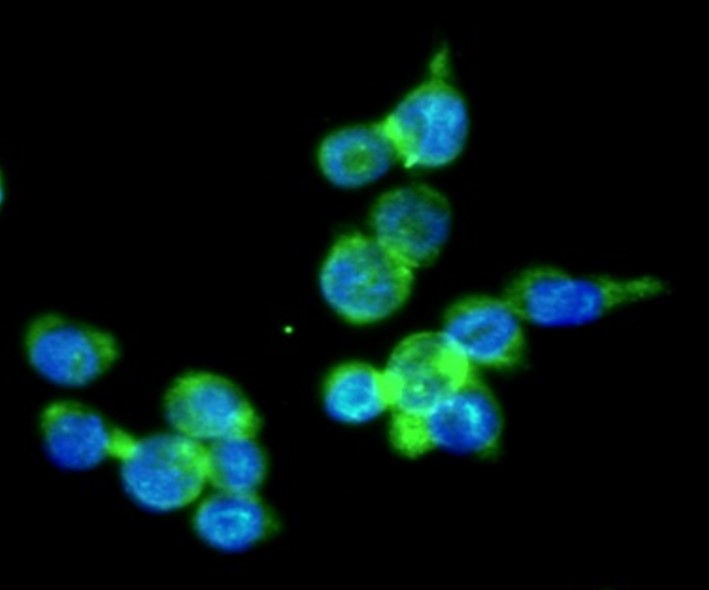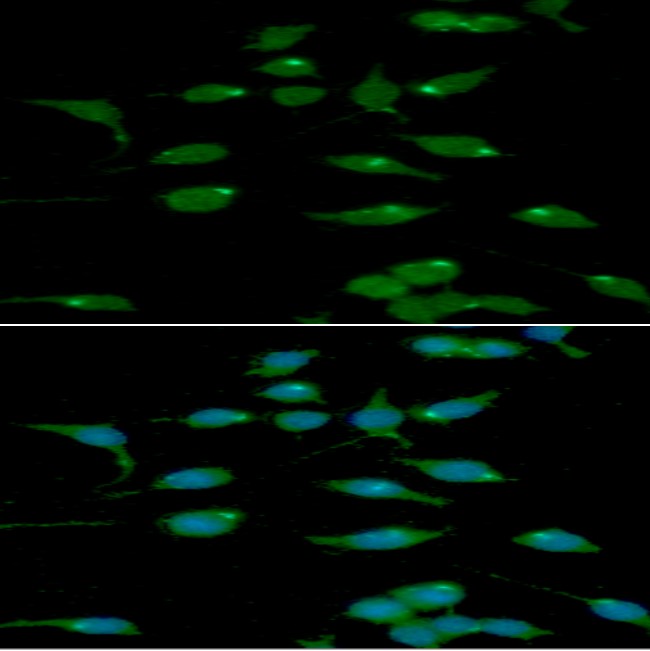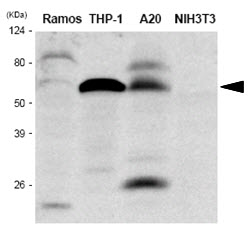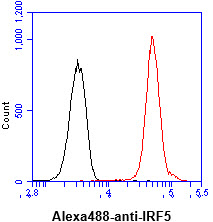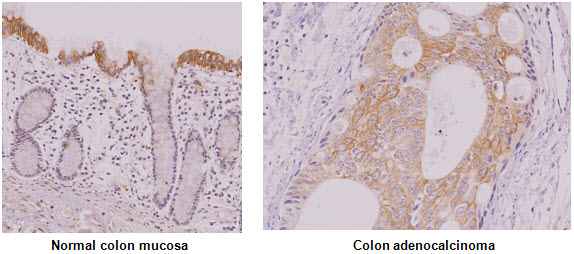Product Information
- Product Type
- Monoclonal Antibody
- Clone Number
- 10T1
- UniProt No.
- Q13568
- NCBI Accession No.
- NP_116032.1
- Alternative names
- interferon regulatory factor 5, irf5
Product Specification
- Host
- Mouse
- Reacts With
- Human
- Concentration
- 1mg/ml (determined by BCA assay)
- Formulation
- Liquid in. Phosphate-Buffered Saline (pH 7.4) with 0.02% Sodium Azide, 10% glycerol
- Immunogen
- Recombinant human IRF-5 (176-240aa) purified from E. coli
- Isotype
- IgG1 kappa
- Purification
- By protein-A affinity chromatography
- Applications
- ELISA, WB, ICC/IF, IHC, FACS
- Usage
- The antibody has been tested by ELISA, Western blot, ICC/IF, FACS and IHC analysis to assure specificity and reactivity. Since application varies, however, each investigation should be titrated by the reagent to obtain optimal results.
- Storage
- Can be stored at +2C to +8C for 1 week. For long term storage, aliquot and store at -20C to -80C. Avoid repeated freezing and thawing cycles.
Data
Immunocytochemistry/Immunofluorescence (ICC/IF)
ICC/IF analysis of IRF-5 in THP-1 cells. The cell was stained with AIR0611 (1:100). The secondary antibody (green) was used Alexa Fluor 488. DAPI was stained the cell nucleus (blue).
ICC/IF analysis of IRF-5 in Raw264.7 cells. The cell was stained with AIR0611 (1:100). The secondary antibody (green) was used Alexa Fluor 488. DAPI was stained the cell nucleus (blue).
Western blot analysis (WB)
The cell lysates of Ramos, THP-1, A20 and NIH3T3 were resolved by SDS-PAGE, transferred to PVDF membrane and probed with anti-human IRF-5 antibody (1:1,000). Proteins were visualized using a goat anti-mouse secondary antibody conjugated to HRP and an ECL detection system.
Flow cytometry (FACS)
Flow cytometry analysis of IRF5 in THP-1 cell line, staining at 2-5ug for 1x10^6cells (red line). The secondary antibody used goat anti-mouse IgG Alexa fluor 488 conjugate. Isotype control antibody was mouse IgG (black line).
IHC Comment And Pic
Paraffin embedded sections of normal colon mucosa and colon adenocalcinoma tissue were incubated with anti-human IRF-5 antibody (1:50) for 2 hours at room temperature. Antigen retrieval was performed in 0.1M sodium citrate buffer and detected using Diaminobenzidine (DAB).
Related Publications
-
Barro M, Patton JT. Rotavirus NSP1 inhibits expression of type I interferon by antagonizing the function of interferon regulatory factors IRF3, IRF5, and IRF7. (J Virol. 2007)
Watanabe T, et al. Muramyl dipeptide activation of nucleotide-binding oligomerization domain 2 protects mice from experimental colitis. (J Clin Invest. 2008)
Ye L, et al. Methamphetamine enhances Hepatitis C virus replication in human hepatocytes. (J Viral Hepat. 2008)
Pandey AK, et al. NOD2, RIP2 and IRF5 play a critical role in the type I interferon response to Mycobacterium tuberculosis. (PLoS Pathog. 2009)
Polioudakis D, et al. A Myc-microRNA network promotes exit from quiescence by suppressing the interferon response and cell-cycle arrest genes. (Nucleic Acids Res. 2013)
Steinhagen F, et al. IRF-5 and NF-κB p50 co-regulate IFN-β and IL-6 expression in TLR9-stimulated human plasmacytoid dendritic cells. (Eur J Immunol. 2013)
He H, et al. Immobilized heavy chain-hyaluronic acid polarizes lipopolysaccharide-activated macrophages toward M2 phenotype. (J Biol Chem. 2013)
O Carroll C, et al. Identification of a unique hybrid macrophage-polarization state following recovery from lipopolysaccharide tolerance. (J Immunol. 2014)
Chionh YT, et al. Protease-activated receptor 1 suppresses Helicobacter pylori gastritis via the inhibition of macrophage cytokine secretion and interferon regulatory factor 5. (Mucosal Immunol. 2015)
Steinhagen F, et al. IRF5 and IRF8 modulate the CAL-1 human plasmacytoid dendritic cell line response following TLR9 ligation. (Eur J Immunol. 2016)
Li D, et al. Specific detection of interferon regulatory factor 5 (IRF5): A case of antibody inequality. (Sci Rep. 2016)
Koelzer VH, et al. Digital analysis and epigenetic regulation of the signature of rejection in colorectal cancer. (Oncoimmunology. 2017)
Xiao Y, et al. An oligodeoxynucleotide with AAAG repeats significantly attenuates burn-induced systemic inflammatory responses via inhibiting interferon regulatory factor 5 pathway. (Mol Med. 2017)
Chen X, et al. MicroRNA-302a suppresses influenza A virus-stimulated interferon regulatory factor-5 expression and cytokine storm induction. (J Biol Chem. 2017)
Note: For research use only. This product is not intended or approved for human, diagnostics or veterinary use.
